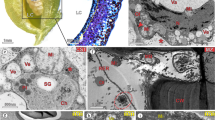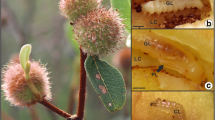Abstract
Marcetia taxifolia (A. St.-Hil.) DC. hosts two gall morphotypes, a pistil-shaped gall induced by a Cecidomyiidae (Diptera) and a fusiform stem gall induced by a Lepidoptera. The cytological study of these galls aimed to answer how the difference in nutritive tissues of Diptera and Lepidoptera galls could be explained on cytological basis. The nutritive tissues of lepidopteran galls have a fast-dividing cell zone, the storage nutritive tissue, which replaces the cells of the typical nutritive tissue, where the larvae feed. The differentiation of multivesicular bodies in the plasma membrane occurred exclusively in these fast-dividing cells of the lepidopteran galls, evidencing the meristematic condition of such tissue. The accumulation of reactive oxygen species (ROS) analyzed in situ in the nutritive cells is not sufficient to induce programmed cell death (PCD), as the cells of M. taxifolia have plastoglobules and accumulate polyphenols and terpenoids, which are diagnostic defenses against oxidative stress. The two taxa of galling insects have different nutritional requirements, thus inducing specific cytoplasm-enriched cells on their nutritive tissues.





Similar content being viewed by others
References
Appezzato-Da-Glória B, Machado SR (2004) Ultrastructural analysis of in vitro direct and indirect organogenesis. Rev Bras Bot 27:429–437
Asada K (2006) Production and scavenging of reactive oxygen species in chloroplasts and their functions. Plant Physiol 141:391–396
Austin JR, Frost E, Vidi P, Kessler F, Staehelin A (2006) Plastoglobules are lipoprotein subcompartments of the chloroplast that are permanently coupled to thylakoid membranes and contain biosynthetic enzymes. Plant Cell 18:1693–1703
Bedetti CS, Ferreira BG, Castro NM, Isaias RMS (2013) The influence of parasitoidism on the anatomical and histochemical profiles of the host leaves on a galling Lepidoptera-Bauhinia ungulata system. Rev Bras Biociências 11:242–249
Bréhélin C, Kessler F (2008) The plastoglobule: a bag full of lipid biochemistry tricks. Photochem Photobiol 84:1388–1394
Bréhélin C, Kessler F, van Wijk KJ (2007) Plastoglobules: versatile lipoprotein particles in plastids. Trends Plant Sci 12:260–266
Bronner R (1992) The role of nutritive cells in the nutrition of Cynipids and Cecidomyiids. In: Shorthouse JD, Rohfritsch O (eds) Biology of insect-induced galls. Oxford University Press, New York, pp 118–140
Carmona D, Lajeunesse MJ, Johnson MTJ (2011) Plant traits that predict resistance to herbivores. Funct Ecol 25:358–367
Chafe SC (1974) Cell wall structure in the xylem parenchyma of Cryptomeria. Protoplasma 81:63–76
Després L, David JP, Gallet C (2007) The evolutionary ecology of insect resistance to plant chemicals. Trends Ecol Evol 22:298–307
Detoni M, Vasconcelos EG, Fontes ES, Aguiar JAK, Isaias RMS, Soares GLG (2010) Differential biochemical responses of Calliandra brevipes (Fabaceae, Mimosoidae) to galling behaviour by Tanaostigmodes ringueleti and T. mecanga (Hymenoptera, Tanaostigmatidae). Austr J Bot 58:280–285
Dreger-Jauffret F, Shorthouse JD (1992) Diversity of gall-inducing insects and their galls. In: Shorthouse JD, Rohfritsch O (eds) Biology of insect-induced galls. Oxford University Press, New York, pp 8–33
Evert RF (2006) Esau’s plant anatomy: meristems, cells, and tissues of the plant body: their structure, function and development, 3rd edn. John Wiley & Sons Inc, Hoboken
Ferreira BG, Isaias RMS (2013) Developmental stem anatomy and tissue redifferentiation induced by a galling Lepidoptera on Marcetia taxifolia (Melastomataceae). Botany 91:752–760
Ferreira BG, Isaias RMS (2014) Floral-like destiny induced by a galling Cecidomyiidae on the axillary buds of Marcetia taxifolia (Melastomataceae). Flora 209:391–400
Ferreira BG, Teixeira CT, Isaias RMS (2014) Efficiency of the polyethylene-glycol (PEG) embedding medium for plant histochemistry. J Histochem Cytochem 62:577–583
Gardoni LCP, Isaias RMS, Vale FHA (2007) Morfologia e anatomia foliar de três morfotipos de Marcetia taxifolia (A. St.-Hil.) DC. (Melastomataceae) na Serra do Cipó, MG. Rev Bras Bot 30:487–500 Gonçalves SJMR, Isaias RMS, Vale FHA, Fernandes GW (2005) Sexual dimorphism of Pseudotectococcus rolliniae (Hemiptera: Coccoidea: Eriococcidae) influences gall morphology of Rollinia laurifolia Schltdl. (Annonaceae). Trop Zool 18:161–169
Heinrich G, Sawidis T, Ingolic E, Stabentheiner E, Pfeifhofer HW (2010) Ultrastructure of glandular hairs of Sigesbeckia jorullensis Kunth (Asteraceae). Isr J Plant Sci 58:297–308
Hori K (1992) Insect secretion and their effect on plant growth, with special reference to hemipterans. In: Shorthouse JD, Rohfritsch O (eds) Biology of insect-induced galls. Oxford University Press, New York, pp 157–170
Isaias RMS, Oliveira DC, Carneiro RGS (2011) Role of Euphalerus ostreoides (Hemiptera: Psylloidea) in manipulating leaflet ontogenesis of Lonchocarpus muehlbergianus (Fabaceae). Botany 89:581–592
Isaias RMS, Carneiro RGS, Oliveira DC, Santos JC (2013) Illustrated and annotated checklist of Brazilian gall morphotypes. Neotropical Entomol 42:230–239
Karnovsky MJ (1965) A formaldehyde-glutaraldehyde fixative of high osmolarity for use in electron microscopy. J Cell Biol 27:137–138
Kostoff D, Kendall J (1929) Studies on the structure and development of certain Cynipid galls. Biol Bull 56:402–458
Kraus JE, Arduin M (1997) Manual básico de métodos em morfologia vegetal. Editora da Universidade Federal Rural do Rio de Janeiro, Seropédica
Lev-Yadun S (2003) Stem cells in plants are differentiated too. Curr Top Plant Biol 4:93–102
Møller IM, Jensen PE, Hansson A (2007) Oxidative modifications to cellular components in plants. Annu Rev Plant Biol 58:459–481
Muravnik LE, Shavarda AL (2012) Leaf glandular trichomes in Empetrum nigrum: morphology, histochemistry, ultrastructure and secondary metabolites. Nord J Bot 30:470–481
Nyman T, Julkunen-Tiitto R (2000) Manipulation of the phenolic chemistry of willows by gall-inducing sawflies. Proc Natl Acad Sci U S A 97:13184–13187
O’Brien TP, McCully ME (1981) The study of plant structure: principles and selected methods. Termacarphi Pty Ltd, Melbourne
O’Brien TP, Feder N, McCully ME (1964) Polychromatic staining of plant cell walls by toluidine blue O. Protoplasma 59:368–373
Oliveira DC, Isaias RMS (2010) Cytological and histochemical gradients induced by a sucking insect in galls of Aspidosperma australe Arg. Muell (Apocynaceae). Plant Sci 178:350–358
Oliveira DC, Magalhães TA, Carneiro RGS, Alvim MN, Isaias RMS (2010) Do Cecidomyiidae galls of Aspidosperma spruceanum (Apocynaceae) fit the pre-established cytological and histochemical patterns? Protoplasma 242:81–93
Oliveira DC, Carneiro RGS, Magalhães TA, Isaias RMS (2011a) Cytological and histochemical gradients on two Copaifera langsdorffii Desf. (Fabaceae)–Cecidomyiidae gall systems. Protoplasma 248:829–837
Oliveira DC, Isaias RMS, Moreira ASFP, Magalhães TA, Lemos-Filho JP (2011b) Is the oxidative stress caused by Aspidosperma spp. galls capable of altering leaf photosynthesis? Plant Sci 180:489–495
Raman A, Ananthakrishnan TN (1983) Studies on some thrips (Thysanoptera: Insecta) induced galls. 2. Fine-structure of the nutritive zone. Proc Indian Nat Sci Acad 6:525–561
Raman A, Dhileepan K (1999) Qualitative evaluation of damage by Epiblema strenuana (Lepidoptera: Tortricidae) to the weed Parthenium hysterophorus (Asteraceae). Ecol Popul Biol 92:717–723
Raman A, Cruz ZT, Muniappan R, Reddy FVP (2007) Biology and host specificity of gall-inducing Acythopeus burkhartorum (Coleoptera: Curculionidae), a biological-control agent for the invasive weed Coccinia grandis (Cucurbitaceae) in Guam and Saipan. Tijdschr Entomol 150:181–191
Reynolds ES (1963) The use of lead citrate at high pH as an electron-opaque stain in electron microscopy. J Cell Biol 17:208–212
Rohfritsch O (1978) Three-dimensional study of cell organelles in the nutritive tissue of a gall (Liposthenes glechomae L. on Glechoma hederacea L.). Protoplasma 95:297–307
Rohfritsch O (1992) Patterns in gall development. In: Shorthouse JD, Rohfritsch O (eds) Biology of insect-induced galls. Oxford University Press, New York, pp 60–86
Rosseti S, Bonatti PM (2001) In situ histochemical monitoring of ozone-and TMV-induced reactive oxygen species in tobacco leaves. Plant Physiol Biochem 39:433–442
Shorthouse JD (1986) Significance of nutritive cells in insect galls. Proc Entomol Soc Wash 88:368–375
Soares GLG, Isaias RMS, Gonçalves SJMR, Christiano JCS (2000) Alterações químicas induzidas por coccídeos galhadores (Coccoidea, Brachyscelidae) em folhas de Rollinia laurifolia Schdtl. (Annonaceae). Rev Bras Zoociências 2:103–116
Staehelin LA (1997) The plant ER: a dynamic organelle composed of a large number of discrete functional domains. Plant J 11:1151–1165
Taylor SH (1949) Initiation and development of the gall of Aylax glechomae on Nepeta hederacea. Am J Bot 36:222–230
Thelen JJ, Ohlrogge JB (2002) Metabolic engineering of fatty acid biosynthesis in plants. Metab Eng 4:12–21
Thomas E, Konar RN, Street HE (1972) The fine structure of the embryogenic callus of Ranunculus sceleratus L. J Cell Sci 11:95–109
Van Doorn WG, Beers EP, Dangl JL, Franklin-Tong VE, Gallois P, Hara-Nishimura I, Jones AM, Kawai-Yamada M, Lam E, Mundy J, Mur LAJ, Petersen M, Smertenko A, Taliansky M, Van Breusegem F, Wolpert T, Woltering E, Zhivotovsky B, Bozhkov PV (2011) Morphological classification of plant cell deaths. Cell Death Differ 18:1241–1246
Vecchi C, Menezes NL, Oliveira DC, Ferreira BG, Isaias RMS (2013) The redifferentiation of nutritive cells in galls induced by Lepidoptera on Tibouchina pulchra (Cham.) Cogn. reveals predefined patterns of plant development. Protoplasma 250:1363–1368
Vieira ACM, Kraus JE (2007) Biologia e estrutura da galha do pedicelo de Byrsonima sericea DC. (Malpighiaceae) induzida por Lepidoptera. Rev Bras Biociências 5:402–404
Zhang GF, Staehelin LA (1992) Functional compartmentation of the Golgi apparatus of plant cells. Plant Physiol 99:1070–1083
Acknowledgments
We thank Coordenação de Aperfeiçoamento de Pessoal de Nível Superior (CAPES), Conselho Nacional de Desenvolvimento Científico e Tecnológico (CNPq), and Fundação de Amparo à Pesquisa do Estado de Minas Gerais (FAPEMIG) for the financial support; Dr. Jane E. Kraus and Dr. Fernando H.A. Vale for useful comments on the results; and Dr. Thiago A. Magalhães and Centro de Microscopia/Universidade Federal de Minas Gerais (UFMG) for technical assistance.
Conflict of interest
The authors declare that they have no conflict of interest.
Author information
Authors and Affiliations
Corresponding author
Additional information
Handling Editor: Hanns H. Kassemeyer
Rights and permissions
About this article
Cite this article
Ferreira, B.G., Carneiro, R.G.S. & Isaias, R.M.S. Multivesicular bodies differentiate exclusively in nutritive fast-dividing cells in Marcetia taxifolia galls. Protoplasma 252, 1275–1283 (2015). https://doi.org/10.1007/s00709-015-0759-8
Received:
Accepted:
Published:
Issue Date:
DOI: https://doi.org/10.1007/s00709-015-0759-8




